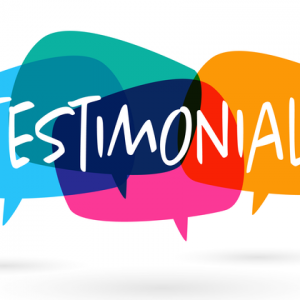If you’ve been an entrepreneur for very long, likely you already know what a testimonial is. But one thing I learned early on is that learning something old in a new way can generate new inspiration. A little humility allows us to see things to which self-assuredness will sometimes blind us.
And, in a way, that’s what testimonials are all about. As a business owner or manager, we need to be humble when it comes to customers and their needs. Instead of thinking that we know it all, we need to let the customer tell us what is what.
Testimonials are all about having customers sell our products and services for us. Their own words are far more potent than any our marketing wizards can devise. Why? Because of believability.

Have you ever heard a claim made by a business and found yourself sceptical? Did you ever find yourself thinking, “Oh, yeah? Prove it!” But that’s just what a testimonial does. A testimonial is praise and validation in the words of a customer. They’ve been there. They know what it’s like not to have your product or service and how everything changed when they decided to buy.
Testimonials create the “social proof factor.” They will answer the following questions and much more:
Will this product help me?
Will it do what they say it will?
Are other people buying it?
What do other people say about it?
What Are Successful Testimonials?
A testimonial that says merely, “I like this product and I would use it again,” is okay, but it doesn’t stir the soul. It doesn’t do much to validate your claims about your product. Feedback, a customer testimonial or recommendation that gives more specifics, will generate far more believability. Short is good, but it needs to say something that will connect to the potential customer. Here’s a testimonial sample:
“I had bought one brand after another, but none of them lasted more than a few weeks. And all of them were hard to operate. Then I found XYZ and all my problems were solved. After two years, my XYZ is still running and simple to use”—Bob Anderson, Bathurst, NSW
What makes this customer testimonial good is that it introduces a problem the customer had experienced. Then it tells how the new product solved that problem. Adding their name and location gives even more credibility to their words. These are not merely fancy expressions made up by a marketing copywriter, but words directly from a real, live customer.
Anyone reading a successful testimonial can find a visceral (gut) connection to it because of the specifics it includes. In a moment, we’ll talk about how you can get those specifics.
But first, did you know that there are three kinds of testimonials?
1. Text Testimonials — By far, this is the easiest to produce. Having a customer write of their experiences in their own words can be influential, but the other two types create even more of an impact.
2. Audio Testimonials — The customer’s own voice can be worth a dozen text testimonials. Not only do you have the customer’s words, but you can hear the sincerity in their voice. It’s harder to fake and therefore more believable.
3. Video Testimonials — Being able to see the customer speak makes video worth a dozen audio testimonials. Not only do you get the sincerity of their voice, but you get to see their body language and the details that make them a unique individual. This makes the video testimonial seem all the more genuine.
Using all three of these can create an even more powerful effect, because you capture every possible dimension of customer feedback. You can sprinkle text testimonials around pages where video or audio may not be easy to include. And save your video presentations for high-profile locations on your website or on a DVD presentation you send to prospective clients.
Asking the Right Questions for Knockout Testimonials
The basic structure of a great testimonial contains a before, during and after. With this simple structure, you’re telling a persuasive story.
Ask them to describe their disappointments before they hired you or purchased from you.
Ask them to describe what it was like to use your service or product.
And ask them to describe a specific benefit that made all the difference to them.
The first question defines the problem. This is where the potential customer reading the testimonial is sucked in. This is the hook that gets them—like the “undeserved misfortune” that defines the tone of a blockbuster movie and begins a hero’s quest.
For the second question, you might want to ask, too, if the customer was initially sceptical and how that scepticism was handled or eliminated.
And finally, you want to know what specific results the customer received that made it all worthwhile. A specific number can help like, “production costs went down by 70%.” If they don’t have any numbers or similar specifics, then ask them how they felt and why. Ask them if they recommended your product or service to anyone else. “I immediately told all my family and friends,” makes a compelling statement of confidence.
The key here is to show how the product or service changed their life. You may not necessarily include a testimonial that speaks to the very problem a potential customer has, but each recommendation will evoke greater confidence in your service or product.
Next, in Part 2
In the second half of this two-part series, we cover some specific things you can do to make your testimonials sparkle. We will include tips on software you can use that will make the job of gathering customer testimonials far easier.
